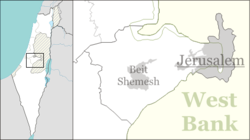Beit Zayit
Beit Zayit
בֵּית זַיִת | |
|---|---|
 | |
| Etymology: House of Olives | |
| Coordinates: 31°46′58″N 35°9′34″E / 31.78278°N 35.15944°E | |
| Country | |
| District | Jerusalem |
| Council | Mateh Yehuda |
| Affiliation | Moshavim Movement |
| Founded | 1949 |
| Founded by | Egyptian, Romanian and Yugoslav Jews |
| Population (2022)[1] | 1,621 |
| Website | www |



Beit Zayit (Hebrew: בֵּית זַיִת, lit. 'House of Olives') is a moshav in central Israel. Located just outside the Jerusalem municipal border to the west, it falls under the jurisdiction of Mateh Yehuda Regional Council. In 2022 it had a population of 1,621.[1]
Beit Zayit lies on the edge of the Jerusalem Forest. Nearby is a dam, built to collect winter flood waters[2] and create the Beit Zayit Reservoir, meant to slow down the flow of the Soreq Stream and allow water to seep into the Western Mountain Aquifer, a task it seems not to fulfill properly (look here for the Hebrew article).
Name
[edit]A village named Beit Zayit is mentioned in the Book[which?] of the Maccabees, but it is believed to have been further north, possibly at the site of the Palestinian Christian town of Bir Zeit, north of Ramallah.[2]
History
[edit]Beit Zayit was established after the 1947-49 Arab-Israeli war on land that had belonged to the depopulated Palestinian village of 'Ayn Karim.[3]
The village was established in 1949 by Jewish immigrants from Egypt, Romania and Yugoslavia. The economy was based on fruit orchards, vegetables, poultry, and other farm products.[2]
With the expansion of the moshav in the late 1990s, including the purchase of land by newcomers and renovation of old homes, Beit Zayit became a trendy alternative to living in Jerusalem.[4]
Dinosaur footprints
[edit]In 1962, dinosaur footprints were discovered in the garden of one of Beit Zayit's residents, and are on display at the Hebrew University of Jerusalem.[5] This is the only place in Israel where evidence of dinosaurs was discovered, and one of few such sites in the Middle East.[6]
In popular culture
[edit]In the Israeli TV show Fauda, the village is visited by the main characters since one of the characters, Yaara, lives there.[7]
References
[edit]- ^ a b "Regional Statistics". Israel Central Bureau of Statistics. Retrieved 21 March 2024.
- ^ a b c Bard, Mitchell G. (2016). "Bet Zayit". Jewish Virtual Library. American–Israeli Cooperative Enterprise. Retrieved May 2, 2019.
- ^ Khalidi, W. (1992). All That Remains: The Palestinian Villages Occupied and Depopulated by Israel in 1948. Washington D.C.: Institute for Palestine Studies. p. 273. ISBN 0-88728-224-5.
- ^ Steinberg, Jessica (2 January 2009). "Posh Israeli suburb grows out of a farming co-op". The New York Times. Retrieved May 2, 2019.
- ^ Sofer, Barbara (1995). Kids Love Israel, Israel Loves Kids: A Travel Guide for Families. Kar-Ben Publishing. p. 103. ISBN 9780929371894.
- ^ Feinberg Vamosh, Miriam (16 September 2013). "Way Before the Flood: Dinosaur Tracks by Jerusalem". Haaretz. Retrieved 2 May 2019.
- ^ "Fauda: Season 3, Episode 12 script". Subs Like Script. Retrieved 18 April 2023.
External links
[edit]- Village website (in Hebrew)


